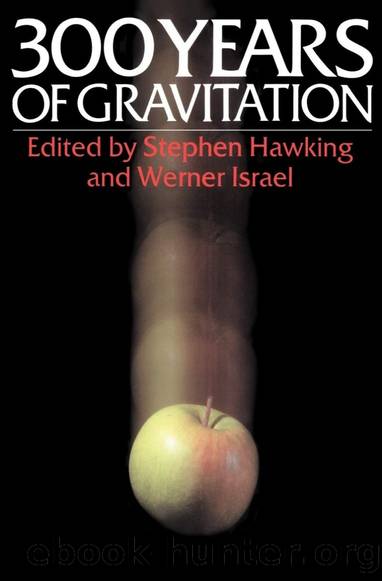Three Hundred Years of Gravitation by Stephen Hawking

Author:Stephen Hawking [Hawking, Stephen]
Language: eng
Format: epub
ISBN: 9780521379762
Barnesnoble:
Published: 2022-07-04T19:14:27+00:00
336
K. S. Thorne
elementary of all ways to compute wave generation, the âquadrupole formalismâ, and its relationship to radiation reaction in the emitting system (Section 9.3.2). Unfortunately, the most strongly emitting systems should violate the mathematical approximations that underlie the quadrupole formalism and thus can be analyzed only in rough order of magnitude using it; for more accurate analyses one must use a more sophisticated wavegeneration formalism. A catalog of more sophisticated formalisms is given in Section 9.3.3 - which is an updated version of a review I wrote ten years ago (Thome, 1977). The theory of the propagation of the waves from source to earth is sketched in Section 9.3.4, and various wave-propagation effects (absorption, scattering, dispersion, tails, gravitational focusing, diffraction, parametric amplification by background curvature, non-linear coupling of waves to themselves, and generation of background curvature by the wavesâ
energy and momentum) are described in Section 9.3.5 -which with 9.3.4 is a shortened version of my recent (Thome, 1983), long review of wave propagation. Section 9.3 concludes with very brief descriptions of elegant mathematical work on idealized wave-propagation situations : the asymptotic structure of waves propagating toward âfuture null infinityâ in an asymptotically flat spacetime (Section 9.3.6), and exact, analytic solutions to the Einstein equations for wave generation and propagation (Section 9.3.7).
It is nearly a decade since a detailed and thorough review has been written of astrophysical sources and detectors for gravitational waves (Smarr, ed., 1979; Douglass and Braginsky, 1979); and in the intervening time these topics have changed enormously. (For recent reviews of a number of subtopics see the chapters in Deruelle and Piran, 1983.) Sections 9.4 and 9.5
attempt a comprehensive review in a manner that closely ties the sources to the detection efforts. In these sections the sources and the detection strategies are split up into three categories : those for gravitational-wave
âburstsâ (Section 9.4. 1 and Fig. 9.4); those for periodic gravitational waves (Section 9.4.2 and Fig. 9.6); and those for a stochastic gravitational-wave background (Section 9.4.3 and Fig. 9.7). All previous reviews have been cavalier about factors of 2 in the definitions of wave strengths and detector sensitivities. This review tries to standardize the definitions, including factors of 2. The standardization is based on signal-to-noise-ratio analyses that are given at the beginnings of Sections 9.4. 1 , 9.4.2, and 9.4.3. For each source that looks favorable for wave detection, Section 9.4 gives a description of our current state of knowledge of the source and gives current estimates of the wave strengths and other wave characteristics.
The burst sources treated in Section 9.4. 1 include supernovae (collapse of
Gravitational radiation
337
a normal stellar core to form a neutron star, subsection c), the collapse of a star or star cluster to form a black hole (subsection d), the inspiral and coalescence of compact binaries (neutron stars and black holes, subsection e), and the fall of stars and small holes into supermassive holes (subsection f).
Because our knowledge of sources is so poor, it is useful to estimate how strong the strongest wave bursts
Download
This site does not store any files on its server. We only index and link to content provided by other sites. Please contact the content providers to delete copyright contents if any and email us, we'll remove relevant links or contents immediately.
The Complete Stick Figure Physics Tutorials by Allen Sarah(7339)
Secrets of Antigravity Propulsion: Tesla, UFOs, and Classified Aerospace Technology by Ph.D. Paul A. Laviolette(5336)
Thing Explainer by Randall Munroe(3911)
The River of Consciousness by Oliver Sacks(3573)
The Order of Time by Carlo Rovelli(3163)
How To by Randall Munroe(3077)
A Brief History of Time by Stephen Hawking(2994)
I Live in the Future & Here's How It Works by Nick Bilton(2963)
What If?: Serious Scientific Answers to Absurd Hypothetical Questions by Randall Munroe(2670)
The Great Unknown by Marcus du Sautoy(2664)
Midnight in Chernobyl by Adam Higginbotham(2519)
Blockchain: Ultimate Step By Step Guide To Understanding Blockchain Technology, Bitcoin Creation, and the future of Money (Novice to Expert) by Keizer Söze(2467)
Networks: An Introduction by Newman Mark(2383)
The Meaning of it All by Richard Feynman(2320)
Easy Electronics by Charles Platt(2309)
The Tao of Physics by Fritjof Capra(2247)
Midnight in Chernobyl: The Untold Story of the World's Greatest Nuclear Disaster by Adam Higginbotham(2200)
When by Daniel H Pink(2098)
Introducing Relativity by Bruce Bassett(2097)
